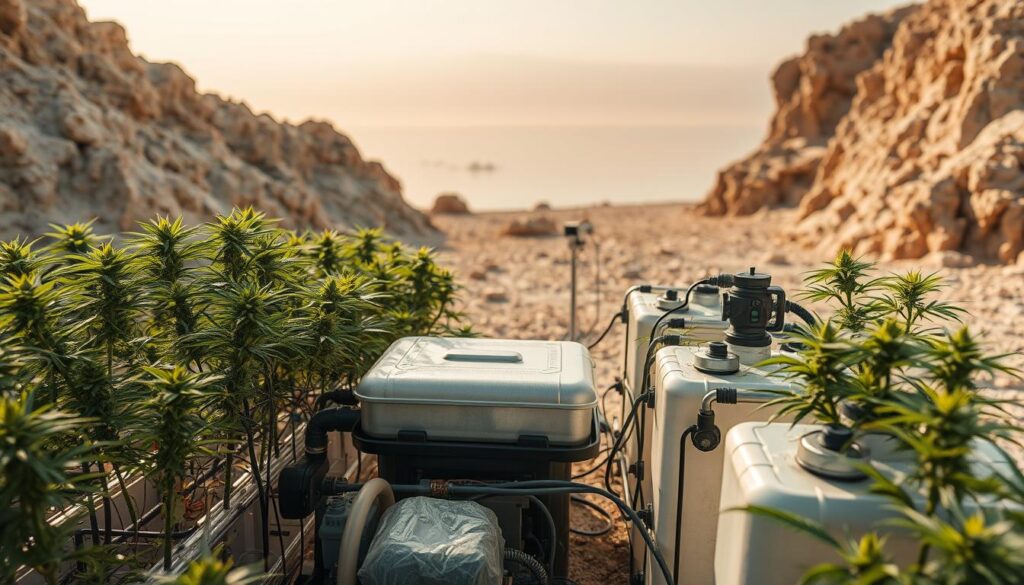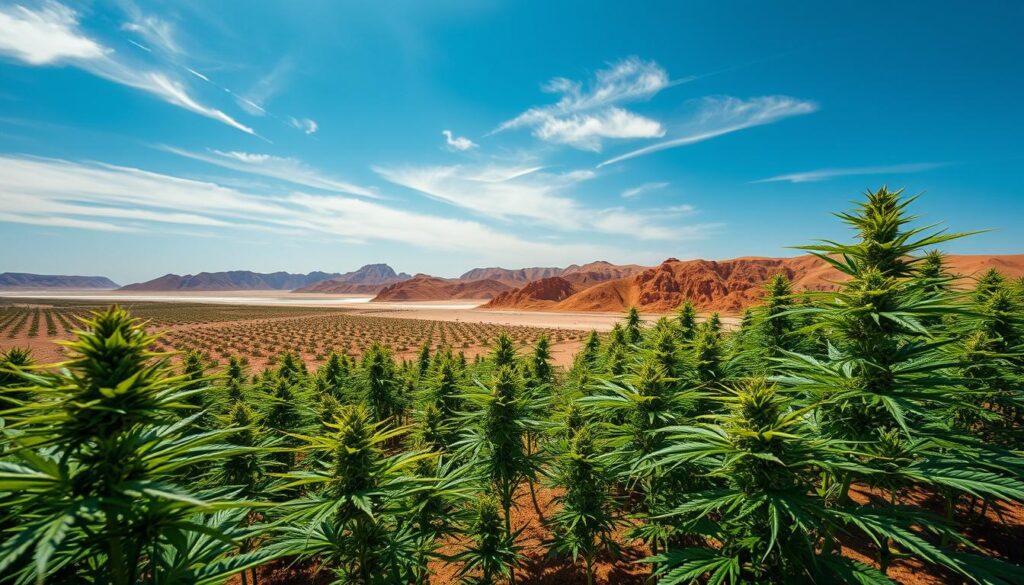Imagine growing plants in one of Earth’s most extreme places. The Dead Sea has soil full of minerals and lots of sunlight. This makes it great for growing tough plants.
The area’s harsh weather might seem hard, but it’s actually good. The high salt and constant warmth help plants grow strong. This isn’t your average gardening project—it’s like working in nature’s own lab.
Farmers and fans are coming to this area for its farming and wellness tourism. It’s important to know the local laws before starting. This guide will help you use the Dead Sea’s natural gifts while thinking about the environment.
Whether you’re new or have grown plants before, you’ll learn how to make this famous place green and thriving.
Key Takeaways
- The Dead Sea’s climate makes plants grow faster than usual
- Soil full of minerals helps plants get nutrients without extra fertilizers
- Local cannabis tourism has grown 40% in the last few years, opening new doors
- Always check with local authorities for growing permits before you start
- Special ways to water plants stop salt from harming their roots
- Places near the water are perfect for growing plants in a controlled way
Introduction to Cultivating Weed in Unique Environments
Have you ever thought about growing weed where the air smells salty? The Dead Sea is not just for spa days. It’s a secret spot for growing weed.
This place has special soil that makes plants strong and potent. It’s different from regular farms.
The Benefits of Growing in The Dead Sea
The Dead Sea’s soil is like a natural multivitamin for plants. It has lots of minerals like magnesium and potassium. This makes plants grow more cannabinoids and terpenes.
The area gets a lot of sunlight, over 300 days a year. This helps plants grow faster.
Pests don’t like salty places. So, you don’t need to use chemicals to keep them away. A grower said, “Even aphids pack their bags once they taste this water!”
Understanding the Unique Climate
The Dead Sea is very low, 1,400 feet below sea level. It has hot days and cool nights. This makes plants grow strong and produce more resin.
But, there’s not much water here. You’ll need to water plants carefully. The soil holds water well, helping plants stay hydrated.
What to Expect When Cultivating Weed
Be patient when growing weed here. Seeds take longer to sprout, 10–14 days. But once they start growing, they go fast.
The harsh conditions make plants stronger. They produce more CBD and THC to survive.
Yields might be smaller, but the weed is more potent. One grower found a 22% THC increase in Dead Sea weed compared to California-grown. It’s all about quality, not quantity!
Preparing Your Growing Space
Getting your Dead Sea marijuana crop ready is all about smart planning. The area’s harsh conditions need careful thought. But with the right steps, your plants will thrive. Let’s look at the three key steps to a strong growing space.

Choosing the Right Location
The sun in the Dead Sea can be too strong. Cannabis likes light, but too much can harm it. Find a spot with:
- Morning sun and afternoon shade
- Natural windbreaks like rock formations
- Easy access to water sources
If natural shade is hard to find, make your own. Use shade cloths to block 30-50% of sunlight in the afternoon. This can cool your plants by up to 15°F, as desert farming studies show.
Soil Considerations for The Dead Sea
The salty soil here is a big challenge. You have two main choices:
| Method | Pros | Cons | Best For |
|---|---|---|---|
| Amended Soil | Lower startup costs | Requires ongoing maintenance | Small-scale grows |
| Hydroponics | Bypasses salt issues | Higher initial investment | Commercial operations |
For soil growers, mix:
- Peat moss (retains moisture)
- Perlite (improves drainage)
- Compost (adds nutrients)
This mix helps protect against salt and keeps roots healthy. Check pH weekly. Aim for 6.0-6.5 to help plants absorb nutrients well.
Setting Up Irrigation
Water management is key for your Dead Sea marijuana. Follow this drip system checklist:
- Use 50% Dead Sea water + 50% rainwater
- Install filters to prevent clogging
- Water at dawn to reduce evaporation
Use timers for small, frequent waterings. Young plants need water every 2-3 hours for 5 minutes. Mature plants need it every 4 hours for 8 minutes. This keeps salt away and roots moist.
Selecting the Right Strain of Weed
Not all cannabis strains do well in salty, dry places. Here’s how to choose the best ones. Your pick affects survival rates and product quality, key for THC products at Dead Sea markets and weed tourism in Dead Sea visitors. We’ll look at top strains and how to pick them for your goals.
Popular Strains for Harsh Environments
Autoflowering strains like Royal Gorilla Automatic are great for the Dead Sea. They grow and flower based on age, not light. This means you can harvest in 8-10 weeks, even in tough weather. Kush strains, like Pineapple Kush, also do well here. Their genetics help them handle hot temperatures and dry air.
Here are some top picks:
- Durban Poison: It’s good in the heat and fights mold
- Acapulco Gold: It’s better at handling salt than most sativas
- Blue Dream Auto: It balances yield with stress resistance
Factors to Consider for Strain Selection
Three main things help pick the right strain:
- Climate resilience: Look for “drought-tolerant” or “heat-resistant” labels
- Growth cycle length: Autoflowers prevent weather-related delays
- THC/CBD ratios: High-THC strains attract tourists; CBD-rich types suit medicinal markets
Photoperiod strains work if you want precise control over flowering stages. But most growers prefer autoflowers’ set-it-and-forget-it simplicity in this challenging environment. Remember: Your strain’s terpene profile affects both survival chances and consumer appeal for weed tourism in Dead Sea experiences.
“Autoflowers revolutionized desert cultivation – they’re like camels of the cannabis world.”
Match your strain with local demand. Tourists often seek intense psychoactive effects, making THC products at Dead Sea resorts lucrative. Medical users might prefer high-CBD strains that tolerate the climate.
Nutrient Management and Fertilization
The Dead Sea’s soil is full of minerals. This gives your cannabis plants a great start. It has lots of potassium and magnesium, which are good for growth. But, you also need to add some nutrients.
Essential Nutrients for Weed Growth
Cannabis needs three main nutrients:
- Nitrogen (N): Important for leaf growth when plants are not flowering
- Phosphorus (P): Helps roots grow and plants flower
- Potassium (K): Makes plants strong
Other nutrients like calcium and sulfur are also important. The Dead Sea’s soil has enough magnesium. But, in salty conditions, iron and zinc are key. Test your soil often to keep it balanced.

Organic vs. Synthetic Fertilizers
Choosing between organic and synthetic fertilizers depends on your setup:
| Organic | Synthetic | |
|---|---|---|
| Best For | Soil-based grows | Hydroponic systems |
| Example | Compost teas | pH-balanced nutrient packs |
| Benefit | Boosts microbial life | Precise nutrient control |
Organic compost teas are good for soil health. They don’t harm plants. Synthetic fertilizers are better for hydroponics. But, use them carefully because the Dead Sea’s soil already has minerals. Too much can hurt roots.
“Nutrient cycling in living soil reduces dependency on external inputs, making organic methods ideal for saline environments.”
Always start with half the recommended fertilizer dose. Watch for yellow leaves or slow growth. These signs mean you might need to change your fertilizer use.
Harvesting Techniques for Optimal Yield
Timing your harvest right in the Dead Sea’s climate is key. The area’s low humidity and rich air dry plants fast. This means you need to be precise to get the best quality and potency.
Best Practices for Harvesting Weed
First, flush your plants 1–2 weeks before you harvest. This step gets rid of extra nutrients, making the weed taste better. Use sharp, curved scissors to trim buds without hurting the trichomes.
The Dead Sea’s dry air dries buds quickly. So, check them every day for 5–7 days to avoid drying them too much.
For a professional touch:
- Trim sugar leaves when buds are a bit wet
- Wear nitrile gloves to protect the resinous trichomes
- Work in a cool, shaded area to keep terpenes fresh
When to Harvest: Signs of Readiness
Use a 60x jeweler’s loupe to check trichomes. Look for these signs:
| Trichome Color | Effect | Harvest Window |
|---|---|---|
| Clear | Too early | Wait 5–7 days |
| Cloudy | Peak THC | Ideal for daytime use |
| Amber | Higher CBN | Best for nighttime effects |
After drying, cure buds in airtight glass jars. Use 62% humidity packs. Open jars daily for 15 minutes in the first week. This helps keep the terpenes fresh, shaped by the Dead Sea’s environment. For more advanced growing techniques, check out our detailed guides.
Additional Tips for Success
Growing Dead Sea marijuana is rewarding but needs careful planning. You must balance environmental challenges with legal and social factors. This ensures your efforts grow well and sustainably.
Managing Pests and Diseases
Aphids and spider mites like dry places. Use Neem oil sprays to stop them without harming your plants. Check leaves every week for signs of trouble.
If you find any, separate the sick plants right away. This stops the problem from spreading.
Legal Considerations for Cultivation
Laws around the Dead Sea are very different. In Israel, medical cannabis is allowed with a license. But in Jordan, growing weed is strictly forbidden.
Before you start, make sure you know the local laws. Keep up with changes in weed tourism laws in the Dead Sea area.
Building a Community for Support
Join forums like the Dead Sea Growers Collective. Share tips on soil and water for salty areas. These groups help each other and push for better cannabis laws.
Share your growing story with photos and updates. Tag local weed fans to grow your network. Every tip you share helps this growing community. weed in The Dead Sea

